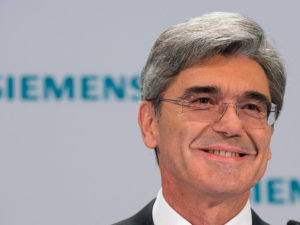Climate action
Addressing Climate Change Is Good Business
How does a company cut its carbon footprint in half in just five years? Joe Kaeser, President and Chief Executive Officer of Siemens tells us how in the following guest blog.
Joe Kaeser, President and Chief Executive Officer of Siemens, reveals the company’s commitment to cutting its global carbon footprint and making global operations carbon neutral by 2030.

A number of major companies – from PepsiCo to Walmart to UPS – have recognized that corporations have a responsibility to address the causes of climate change before it is too late.
We do not have to wait for an international treaty or new regulations to act. At Siemens, the global industrial manufacturing company I lead that makes everything from wind and gas turbines and automation systems to high-speed trains and M.R.I. machines, we understand that taking action is not just prudent – it’s profitable.That’s why, today, we are committing to cut our global carbon footprint in half by 2020 and to make our global operations carbon neutral by 2030. We will accomplish this by eliminating a vast majority of our carbon emissions, while also supporting projects that reduce greenhouse gas emissions outside of Siemens, known as carbon offsets. Our net CO2 emissions will be zero.
Worldwide, Siemens employs more than 340,000 people, does business in over 200 countries, and operates nearly 300 major production sites. Last year, we were responsible for 2.2 million metric tons of carbon emissions. That means our global carbon footprint is about three-quarters that of Washington, D.C., where our United States headquarters is.
So how does a company cut its carbon footprint in half in just five years? We’re targeting facilities, vehicles and fuel.
Over the next three years, we plan to invest more than US$110 million to improve energy efficiency at offices and factories, including sites in the United States, Germany, China, Brazil and Britain.
Over the next three years, we plan to invest more than US$110 million to improve energy efficiency at offices and factories, including sites in the United States, Germany, China, Brazil and Britain. These investments are based on existing strategies and promising results.
At our gas turbine plant in Berlin, we installed automated heating and ventilation systems and moved to more energy-efficient lighting. At our plant in Sacramento, where we build light-rail vehicles and Amtrak locomotives, we installed solar panels that generate about 80% of the plant’s energy needs.
While time consuming and labour intensive, requiring us to go system by system and location by location, the effort is paying off. Between 2010 and 2014, we increased our facilities’ carbon efficiency by approximately 20 percent. We also will require Leadership in Energy and Environmental Design certification for all our new buildings, including our new global headquarters in Munich, Germany.
We will also focus on our company fleet of about 45,000 vehicles producing roughly 300,000 metric tons of carbon emissions per year. In Germany and elsewhere, we have already lowered emissions by the purchase of more fuel-efficient cars for our employees and service teams. Now we’ll do this on a global scale.
We will increase our use of distributed energy systems at our own sites – by combining solar panels, wind and highly efficient gas turbines with intelligent energy management, smart grids and energy storage solutions.
We expect our US$110 million investment to pay for itself in just five years and generate US$20 million in annual savings thereafter.
Finally, we will buy clean power. To make up for the emissions that cannot be avoided in the near term, we will purchase electricity from renewable sources like wind parks and “carbon credits” from credible organizations working to reduce carbon around the world, ranging from reforestation efforts to updating power plants.
Through these steps, we hope to demonstrate to other companies that cutting your carbon footprint is not only possible, but profitable. With today’s software and technology, it’s easier than ever before to increase efficiency. And while it requires a substantial investment, it will pay for itself quickly. In fact, we expect our US$110 million investment to pay for itself in just five years and generate US$20 million in annual savings thereafter.
In other words, cutting your carbon footprint is not only good corporate citizenship – it’s also good business.
I do not want to make this effort sound simple. This requires major support at all levels of the company, particularly at the board level. It requires that we take a longer-term view when it comes to investment decisions. It means accepting a longer payback period for energy-efficiency measures.
But no effort can be spared and all of us must do something. While we remain hopeful that global policymakers will come to an agreement at the United Nations Climate Change Conference in Paris, we also know that the business community does not have to wait to act.
This article was originally published in the International New York Times on 22 September, 2015.
How to achieve a low-carb future? Join our #COP21 Q&A with @Siemens Jan Rabe on 6/12. Submit your Qs now to @iccwbo pic.twitter.com/uLoABWymjc
— ICC WBO (@iccwbo) 27 novembre 2015
